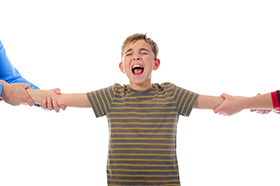
By Katie Davis
Shared custody seems to be on the rise.
In a recent study of Wisconsin Court Records, published in “Demography,” it was shown that from 1998 to 2008, the percentage of mothers awarded sole custody of their children dropped from 80% to 42%.
Additionally, this significant drop in sole custody for mothers was matched by a rise in joint custody arrangements for that same time frame. Equal shared custody (joint physical custody) went from 5% to 27%, and unequal shared custody (joint legal custody) jumped from 3% to 18%.
Perhaps, courts are starting to pay attention to the research. Perhaps, divorce culture and the way people view parenting is developing a bit. But, either way, the growth of joint custody is there.
Divorce Source points out that children living in a joint physical custody arrangement, where they can spend equitable time at both parents’ homes, are able to have stronger relationships with both of their parents. This arrangement can also dispel possibilities for Disneyland parent issues.
“Children in shared custody have ‘normal time’ with both parents. This avoids the situation where mom, the custodial parent, competes with her former husband, a ‘Sunday dad,’ who lavishes gifts and treats on his children in an effort to compensate for absence,” reports Divorce Source.
Despite this progression toward the shared custody trend, parents can still face difficulties knowing how to best behave in these arrangements.
Kate Bayless with Parents Magazine addressed some of the best tips for shared custody parents in her article, “9 Rules to Make Shared Custody Work.”
One of the tips reminds parents that “It’s not about you.” Rather, custody is about the children involved.
Best practices also involve speaking no evil about your ex, especially while around the kids, being realistic about your schedule and commitments when planning shared parenting times and choosing a custody arrangement that fits your kids’ ages and needs.
At the end of the day, it’s also important to remember that “A bad spouse doesn’t equal a bad parent.”
While making shared custody, whether joint physical or joint legal custody, work can be a bit tricky and require some sacrifices from the divorced parents involved, it can be done.
As the courts and society’s overall thinking starts allowing for more equal shared parenting time, divorced parents will want to learn how to best accommodate their children’s needs, what arrangements work best for their families and how they can step up to the plate.

